Early Years: 1800's
The Franklin of today was first settled in 1748. It was, at that time, called Stevenstown, later incorporated as Salisbury.
A petition for a new town was presented to the Legislature in 1825. The petition was bitterly opposed by the towns who would have to give up parts of their lands, the result being that several years would elapse before the matter was settled.
The people who wanted a new town persevered and as a result, Franklin, the Town, was incorporated on December 24, 1828. It would become a city in 1895.
As early as 1830, an important duty of town government was to see that the property of its citizens was protected against the ravages of fire.
Soon the town would have two fire “engines” in use. These were known as tub machines. There were two organized fire companies, located on each side of the Pemigewasset River, in the two villages. Just when they were formed, is not known. One was most definitely Engine Company no. 1, in the West Village.
In 1832, a group of Franklin citizens gave notice that Engine Company 2 had been formed.
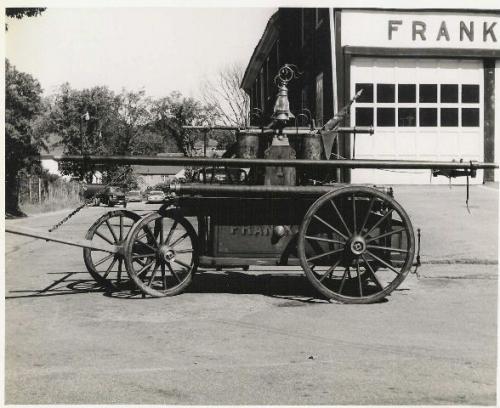
It is believed that these early companies consisted of 20 men each. Just what their “engines” were is not known, but they were the forerunners of the hand-tub now in possession of the Department.
The first recorded fire in the community occurred in November 1835. The fire bell was rung at 4 am for a fire in West Village. The fire started in the Satinet Factory, where Benjamin Moulton had been manufacturing cloth and carding wool. The building could not be saved as the fire spread to a barn and carriage shed, destroying them too.
In 1837, April 27, fire started in one of the mills on Central Street, and soon spread to another. Before the flames could be brought under control, both mills, along with a book and paper store were totally consumed.
Using the $8,000. insurance money, the brick mill was rebuilt on site and was in full operation on the 29th of October.
The following appeared in the records of Engine Company 2. “June 1, 1850 Engine Co. met at Engine House precisely at 7 o’clock pm, examined engine, pronounced it to be in good order, worked it and found it to be as above stated. Captain Knapp took his Company to D.N. Haley’s Inn and treated them on Lemon Ale, in good shape. Returned to Engine House and the Captain dismissed the Company.”
In 1853, Franklin purchased a new Hunneman Engine. It had a 5 inch cylinder, 24 feet of suction hose, buckets, axes, spanners, lanterns and a hose reel with 350 feet of leather riveted hose. It would remain in service until 1892. This Engine is still in our possession, housed in the Museum behind the Fire Station.
A second hand Hunneman Engine was purchased from Stark Mills in Manchester in 1866 and would run in the East Village as Stark company No. 3. It would be housed on Central Street and would serve until 1880. In 1884, the Engine would be sold to Lyndonville, Vermont. Franklin had paid $400. for the Engine. Also purchased at this time was $800.00 worth of leather riveted hose. This engine would have been second hand, possibly no longer needed by Stark Mills.
In 1870, a new West Village Fire Station was constructed. Samuel Heath did the stone work for $194.60. The builder was J.K. Woodward who charged $967.80 for his work. Total expenses for the new house were $1705. This station would be remodeled in 1941 to better serve motorized apparatus.
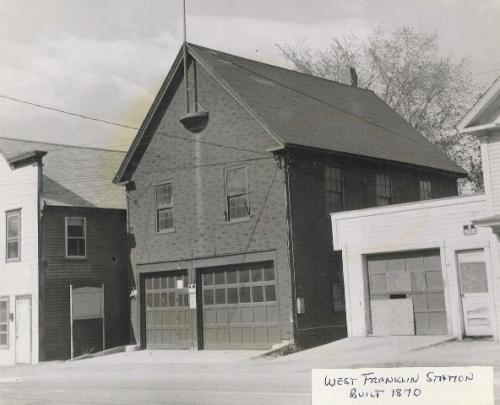
On October 10, 1865, fire struck Aiken’s four story wooden machine shop on Bow Street. Fire started on the top floor and slowly devoured the building. This shop had been built in 1864. Such large buildings would be almost impossible to extinguish. As some of the old records stated, “fire buildings were destroyed, all surrounding buildings were saved”.
July 7, 1872 saw fire strike the Winnipesaukee Paper Mill. The building was 40 X 108 feet, two stories with a connected bleach house 33 X 28 feet. The fire was believed to have started from the bleach, which was subject to intense heat. The fire spread quickly to the extremely dry flooring overhead. The fire was discovered by the watchman who sounded the alarm.
Stark Engine No. 3 was quickly on scene followed shortly by Engine No. 1. Stark 3 threw the first stream but the building was completely involved and could not be saved.
Two rotary bleachers, one five feet in diameter and 22 feet long, weighing 13 tons and the other six feet in diameter and weighing 10 tons were filled with boiling stock. When the building was half destroyed, one of the bleachers exploded and was propelled over 200 feet across the river.
Five firemen were playing a 2 1/2 inch hose on the fire at the time of the fire and all five were knocked to the ground but were unharmed. At this time, it was discovered that part of the bleacher had gone 30 feet in the opposite direction. Before the fire was under control, the second bleacher also exploded.
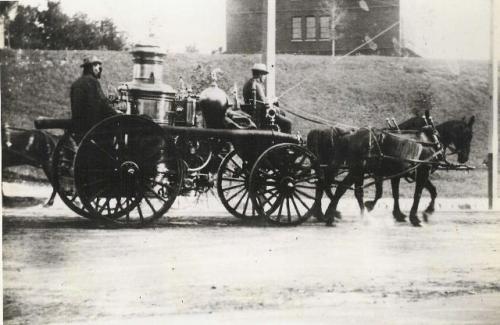
Firemen worked their engines for over three hours and were so exhausted that by-standing men were pressed into service working the brakes. The brakes were long handles that firemen pumped up and down to force water from the engine to the nozzle. Damage was $50,000.
It is believed that horses were introduced to the Department during 1877. These horses were city horses and had to be “rounded up” to haul fire apparatus.
A new hose wagon was purchased from Chelsea, Massachusetts. A new company was formed to run with the hose wagon. It was called the C.C. Kenrick Hose Company, and ran out of the East Village. The Company ran with volunteers until 1879 when they drew pay. In 1880, Kenrick Hose Company was done away with and the fifteen members were used to form a new company for the steamer purchased.
May 1880 saw the purchase of a steam fire engine. It was purchased from Amoskeag at Manchester at a cost of $2985. This new engine would be called the Daniel Webster Steamer. It was a double reciprocating, vertical engine, with two team cylinders and two pumps. It would deliver 500 gallons of water per minute. It was furnished with such tools and equipment as were required. With the arrival of the Steamer, came a complete reorganization of the Fire Department. Stark No. 3 was disbanded and the machine sold. Engine Co. 1 was reduced from 50 men to 15, as they would not be used as much as previously. They would run on second alarms with the Hunnaman Hand tub.
In July of 1880, the town purchased a Ladder Truck (horse drawn) for $325.00. No Ladder Company would be formed until November 1892.
In 1880, after Start Engine 3 was put out of service and its engine house was sold for $195.00, equipment and apparatus was housed in the new firehouse on Central Street.
The tower of the engine house was raised fifteen feet to allow hose to be hung full length. At this time, 2700 feet of rope was used in the process of hanging hose. It was said the newer tower added beauty to an already attractive building. Franklin now had one of the most “handsome and convenient an Engine House in the State.”
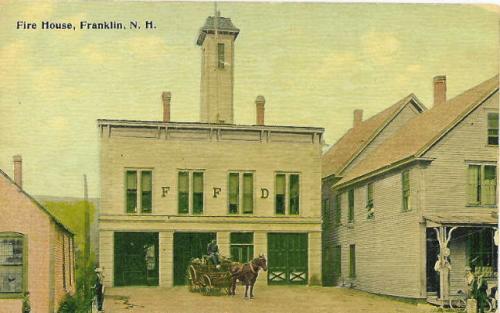
The most severe fire of the decade occurred on January 7, 1888. The blaze would destroy the Cross Pump Mill on the Winnipesaukee River. The fire started at 5 am near a “hot box and although several employees were present nobody seemed to understand that water is a good thing to use on such occasions.”
In a short time, the whole building was in flames and nothing could be done to save it. The fire also spread to a large pulp wood storage shed, which was also destroyed. Loss was $100,000. In dollar value, this fire exceeded the paper mill fire of 1872.
Franklin’s water system was established in 1891. Sixty-five hydrants were installed and a covered masonry reservoir was built on Pleasant Street. This reservoir was the second one built in New England and the first circular one. Total cost of the system was $85,000. The capacity of the reservoir was 504,300 gallons.
Prior to this system, water for firefighting was stored in covered ground reservoir throughout the community and natural sources, such as lakes, ponds and rivers.
Also in 1892, Engine No. 1 was put in reserve and the Company was disbanded. Engine Co. No. 1 had served for 60 years.
A new hose carriage was purchased and a new company was formed. Ten men were accepted to form Hose Company No. 1.
Another new company was formed on November 18, 1892 to run with the ladder truck purchased in 1880.
In 1894, Chief Engineer Fred Aikens recommended a hose reel be put on Willow Hill, and another on Prospect Hill, “which would be of greatest service in cases of fire in either of these localities”. His ideas were adopted and eventually, hose reel houses were placed in areas where, during winter, apparatus could not go. The original reel house that was utilized at the New Hampshire Orphan’s Home here in Franklin is still in the Departments’ possession at the Museum, with the original hose reel.
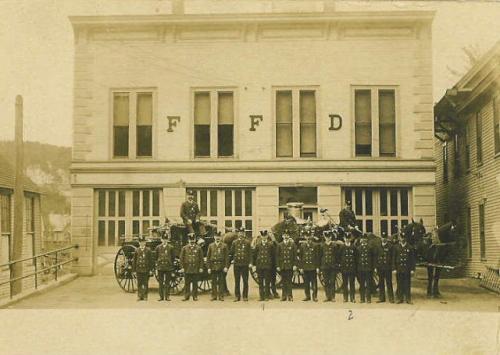
January 1895, Chief Elias Ayles asked City Council for a “better system of giving an alarm (of fire). It is imperative, as we are now situated, it is often necessary to travel quite a distance before an alarm of fire can be sounded and much valuable time is thus wasted. A fire alarm system with a few boxes placed in different parts of the city would be of the greatest help in directing firemen.”
In March it was voted by the Council to purchase a hose wagon from the Boston Woven Hose Company, a one horse wagon and equipment for $310.00. it was light and strong with two Holloway Pony Extinguishers (soda and acid), two axes, two lanterns and a gong.
At this time, early 1896, the Chief and Firewards voted that “Hose Company No. 1 shall not report on first alarms, but to report on second alarms only.” Apparently the steamer was doing a good job and at most fires it was the only apparatus needed.
By September 1896, a new fire alarm system had been installed. Six new boxes had been located in various parts of the city, connected to a gong (steam whistle) located on a paper mill near the fire house. This system was also connected to the Baptist and Christian Churches, where apparatus for ringing the church bells, to coincide with the alarm box, was installed.
This system would work well as long as there was a head of steam at the paper mill. When the mill was closed this system, except for the church bell, would not work. Eventually, a better system would be installed.
On January 11, 1898, the steamer company took the hose out of the wagon and loaded it on a sleigh for the winter, as the roads were impassable for wheeled vehicles. This action would continue each year until the roads would be plowed instead of rolled.
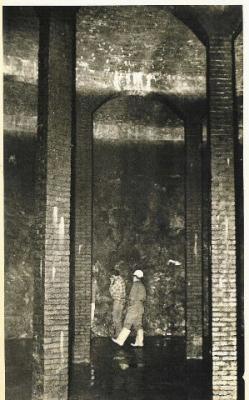
On October 5, 1899, Daniel Webster Steamer Company voted to do away with the terms, Foreman and Assistant Foreman and hereafter refer to Captain and Lieutenant. The other company’s must have followed their example as we do not see these old terms used after this time.

